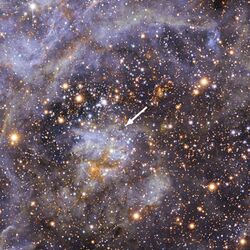Astronomy:Relativistic star
A relativistic star is a rotating star whose behavior is well described by general relativity, but not by classical mechanics. The first such object to be identified was radio pulsars, which consist of rotating neutron stars. Rotating supermassive stars are a hypothetical form of a relativistic star.[3] Relativistic stars are one possible source to allow gravitational waves to be studied.
Another definition of a relativistic star is one with the equation of state of a special relativistic gas. This can happen when the core of a massive main-sequence star becomes hot enough to generate electron-positron pairs. Stability analysis shows that such a star is only marginally bound, and is unstable to either collapse or explode. This instability is believed to limit the mass of main-sequence stars to a couple of hundred solar masses or so. Stars of this size and larger are able to directly collapse into a black hole of either intermediate or supermassive size.[4]
References
- ↑ "VLT Finds Fastest Rotating Star". ESO Science Release. http://www.eso.org/public/news/eso1147/. Retrieved 12 December 2011.
- ↑ "Fastest Rotating Star Found in Neighboring Galaxy". http://www.nasa.gov/multimedia/imagegallery/image_feature_2141.html. Retrieved 2011-12-29.
- ↑ Baumgarte, Thomas W.; Shapiro, Stuart L. (June 24, 2010). Numerical Relativity: Solving Einstein's Equations on the Computer. Cambridge University Press. p. 459. ISBN 9780521514071. https://books.google.com/books?id=dxU1OEinvRUC&pg=PA459.
- ↑ Nikolaos Stergioulas (2003-03-07). "Rotating Stars in Relativity". http://relativity.livingreviews.org/Articles/lrr-2003-3/.
External links
 |


